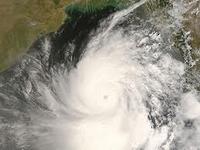-
New process doubles production, slashes costs of butanol
Butanol has a 30 percent higher energy content than ethanol, lower vapor pressure, and is less volatile, less flammable, and mixes well with gasoline; a new discovery should make butanol more attractive to the biofuel industry
-
-
Health consequences of the Fukushima disaster
The results of two studies in the 15 August issue of JAMA report on the psychological status of workers at the Fukushima nuclear power plants in Japan several months after the earthquake and tsunami in March 2011, and the amount of internal radiation exposure among residents of a city north of the power plant that experienced a meltdown
-
-
Farmers upset by plan for water banking system

Depending on the depth of the drilling, it can take anywhere from two gallons to two million gallons of water to frack one well; drilling companies consumeenough water in their fracking operations to meet the needs of between 66,400 and 118,000 households; in the parched Midwest, farmers raise questions about water-use priorities
-
-
Hurricanes which pass over fresh water can be stronger

About 60 percent of the world’s population resides in areas that are prone to hurricanes or cyclones; researchers find that if a hurricane’s path carries it over large areas of fresh water, it will potentially intensify 50 percent faster than those that do not pass over such regions, meaning it has greater potential to become a stronger storm and be more devastating
-
-
Earthquake risks in Europe

How strong can earthquakes in Germany be? Where in Europe are the earthquake activities concentrated? These questions are the basis for risk assessments and become relevant when it comes to the safety of buildings or the generation of tsunami; a new Earthquake Catalogue for Europe and the Mediterranean, which offers details of 45,000 earthquakes during the last millennium, suggests answers to these questions
-
-
Wind farms pose risks to ultra-light aircraft
Airfields for ultra-light aircraft are typically constructed on level ground — and so are wind farms; do wind power plants generate turbulence that could endanger lightweight planes? A simulation can compute how these power plants influence aircraft at various wind speeds and wind directions
-
-
Obama considering executive order for infrastructure protection
President Barack Obama is exploring whether to issue an executive order to protect the U.S. critical computer infrastructure from cyber attacks; White House sources say an executive order is being considered after a 2 August procedural vote in the Senate that all but doomed a scyberecurity bill endorsed by Obama as well as current and former national security officials from both Republican and Democratic administrations
-
-
Climatic impacts of megapolitan expansion
Arizona’s Sun Corridor is the most rapidly-growing megapolitan area in the United States. Nestled in a semi-arid environment, it is composed of four metropolitan areas: Phoenix, Tucson, Prescott, and Nogales. With a population projection expected to exceed 9 million people by 2040; a first study of its kind, attempting to quantify the impact of rapidly expanding megapolitan areas on regional climate, showed that local maximum summertime warming resulting from projected expansion of the urban Sun Corridor could approach 4 degrees Celsius
-
-
Engineers solve leaky water pipes problem

Leaky pipes are a common problem for the water industry: according to the U.K. Water Services Regulation Authority (OFWAT), between 20 and 40 percent of our total water supply can be lost through damaged pipes; developing more accurate ways of finding leaks would enable water companies to save revenue and reduce their environmental impact
-
-
Wastewater key to addressing growing global water shortage

Parched cities and regions across the globe are using sewage effluent and other wastewater in creative ways to augment drinking water, but four billion people still do not have adequate supplies, and that number will rise in coming decades
-
-
Water sustainability flows through complex human-nature interactions
The fate of water in China mirrors problems across the world: water is fouled, pushed far from its natural origins, squandered, and exploited; China’s crisis is daunting, though not unique: two-thirds of China’s 669 cities have water shortages, more than 40 percent of its rivers are severely polluted, 80 percent of its lakes suffer from eutrophication — an over abundance of nutrients — and about 300 million rural residents lack access to safe drinking water
-
-
Concerns about U.S. grid grow along with demand for power

The U.S. grid is stretched to capacity and severely outdated; some experts fear that blackouts in the past years in New York, Boston, and San Diego will become more frequent in the near future unless a multi-billion dollar overhaul is worked out
-
-
World facing increasingly challenging water situation
New measure developed for sustainability of global groundwater water supply points to overuse of water in Asia and North America; approximately 1.7 billion people, most residing in Asia, live in areas where groundwater resources or groundwater-dependent ecosystems are under threat
-
-
July flooding in China causes $8.3 billion of economic losses

Insurance industry faces agriculture losses from China to the United States in July 2012: flooding caused more than $8.3 billion in economic losses across China during July, while the worst drought in decades worsened across much of the United States; severe weather also prompted widespread damage in parts of the United States and Europe
-
-
California’s hydropower is vulnerable to climate change
Fifteen percent of California’s electricity comes from hydropower, a cheap and relatively clean energy source; .about 75 percent of this hydropower comes from high-elevation units, located above 1,000 ft.; with most of them located in Northern California and the Sierra Mountains; if California loses snowpack under climate warming, these high-elevation reservoirs might not be able to store enough water for hydropower generation in summer months when the demand is much higher
-
More headlines
The long view
Falling Space Debris: How High Is the Risk I'll Get Hit?
An International Space Station battery fell back to Earth and, luckily, splashed down harmlessly in the Atlantic. Should we have worried? Space debris reenters our atmosphere every week.
Using Drone Swarms to Fight Forest Fires
Forest fires are becoming increasingly catastrophic across the world, accelerated by climate change. Researchers are using multiple swarms of drones to tackle natural disasters like forest fires.
Strengthening the Grid’s ‘Backbone’ with Hydropower
Argonne-led studies investigate how hydropower could help add more clean energy to the grid, how it generates value as grids add more renewable energy, and how liner technology can improve hydropower efficiency.
LNG Exports Have Had No Impact on Domestic Energy Costs: Analysis
U.S. liquified natural gas (LNG) exports have not had any sustained and significant direct impact on U.S. natural gas prices and have, in fact, spurred production and productivity gains, which contribute to downward pressure on domestic prices.
